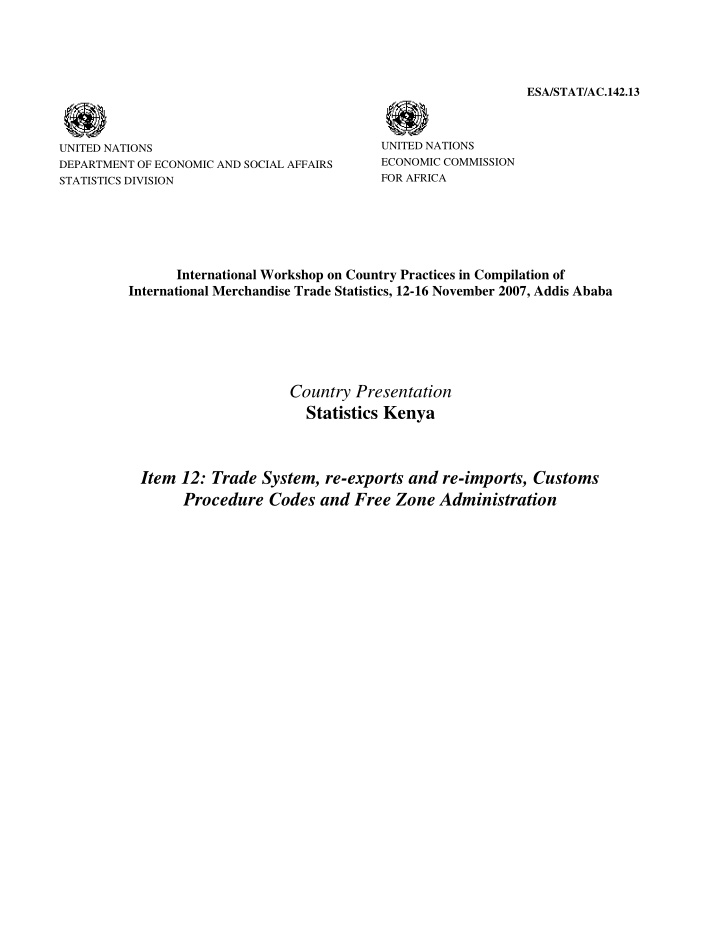



ESA/STAT/AC.142.13 UNITED NATIONS UNITED NATIONS ECONOMIC COMMISSION DEPARTMENT OF ECONOMIC AND SOCIAL AFFAIRS FOR AFRICA STATISTICS DIVISION International Workshop on Country Practices in Compilation of International Merchandise Trade Statistics, 12-16 November 2007, Addis Ababa Country Presentation Statistics Kenya Item 12: Trade System, re-exports and re-imports, Customs Procedure Codes and Free Zone Administration
1 Background Information – Kenya Area: 580,367 km 2 Water : 2.3% Arable land: 5% Pop : 34,707,817 34,707,817 Density: : 59 59 /km /km² ² Density Real GDP: US$ 18.7 billion Real GDP: (5.7%) - - (2005) (2005) (5.7%) GDP Per Capita: US$ 535.9 GDP Per Capita: Real GDP: 6.1% (2006) Real GDP: 6.1% (2006) Exchange rate : 1 US$ = KSh. 75.55 (2005) 2 1
Overview of Kenya National Bureau of Statistics (KNBS) � KNBS is a government department, in the Ministry of Planning and National Development mandated by law to collect, analyze and disseminate socio-economic statistics needed for planning and policy formulation. 3 Overview of EPZs - Kenya � EPZs - program commenced in 1992 following the enactment of CAP 517 Laws of Kenya, which also created the EPZs Authority (EPZA) as the regulatory body. � Production activities began in 1993, effectively. � Factors for establishment of EPZs - Kenya: � relatively large & dynamic private sector, � a low cost but well trained labour force, and � relatively good infrastructure, among others. 4 2
Overview of EPZs – Kenya Cont. � Objectives of the EPZ program: � Attraction of new investment � Expansion & diversification of export products & markets � Employment creation � Technology transfer & skills upgrading � Linkage development thro’ local resource utilization & foreign exchange earnings 5 Customs Procedures � Kenya uses the Kyoto Convention as the basis for the definitions of Customs procedures. � Hence, recording by customs procedures allows for the identification of goods admitted/leaving the commercial or industrial free zones. � There’s a clear link between goods entering or leaving the zones 6 3
Trade System in Kenya � Customs department of the Kenya Revenue Authority (KRA) collects and process trade statistics concerning all elements within the framework of the General Trade system. � Coverage comprises all goods that enter or leave economic territory whether dutiable or not. In terms of coverage this accords with BOP requirements 7 Trade System in Kenya Cont. � Goods entering/leaving the following territorial elements are included in the trade statistics: � Industrial free zones (w.e.f 2005) � Commercial free zones (w.e.f 2005) � Customs warehouses � Premises designated for inward processing 8 4
Trade System in Kenya Cont. � Trade statistics is disseminated only according to the General Trade System as opposed to Special Trade System. � On the ground of the existing institutional agreement, Customs Authority records trade for EPZA & sends data to KNBS. 9 Time of Recording � Basing on the convention for recording goods, recording cannot be done simultaneously by exporter/importer. Hence, change of ownership can’t be used as a basis of inclusion of certain goods in the trade statistics. � Compilation of detailed commodity by partner trade statistics on the basis of change of ownership is not easy. 10 5
Partner Country � Trade partners are identified on the basis of the statistical territory as given by partners themselves. � Import statistics are compiled by Country of Origin in accordance with the ‘origin criteria’ outlined in the Kyoto convention. � They are also compiled by country of consignment but not country of purchase. � Imports are recorded for the country of granted, but not requested preferential treatment. 11 Partner Country Cont. � When the country of origin changes to Kenyan origin, new customs declaration forms must be completed. � Export statistics are compiled by country of last known destination and by country of consignment. � However, they are not compiled by country of sale. 12 6
Processing Activities � Kind of processing � In industrial free zones food processing & agro-processing, wood based products, � leather & animal based products, building materials, other minerals – processing � pharmaceutical/cosmetic/medical, packaging, textiles, electronics/electrical/engineering goods, transport equipment based products – processing. � printing & publishing services � In commercial free zones � order taking & re-packing e.g. coffee & tea packaging � bulk-breaking & trading operations 13 EPZ Performance :2001-2005 Indicator 2001 2002 2003 2004 2005 Growth % 23 31 37 41 43 4.9 Gazetted zones (No.) Enterprises Operating (No.) 39 54 66 74 68 -8.1 Total Employment 13,758 27,148 39,111 38,560 38,844 0.7 Total sales (Kshs. Million) 6,499 11,040 14,817 24,217 23,774 -1.8 Exports (Kshs. Million) 5,962 9,741 13,812 23,047 20,036 -13.1 538 932 619 651 3,160 385.4 Domestic Sales (Kshs. Million) Imports (Kshs. Million) 3,990 7,043 9,920 13,029 12,497 -4.1 Investment Kshs. Million 8,950 12,728 16,716 17,012 17,637 3.7 1 718 1,127 1,176 1,893 2,388 26.1 Expenditure on local Purchases (Kshs M) 14 7
EPZ Performance : 2001 2005 30,000 25,000 20,000 15,000 10,000 5,000 0 2001 2002 2003 2004 2005 Year Total sales (Kshs. Million) Exports (Kshs. Million) Domestic Sales (Kshs. Million) Imports (Kshs. Million) Investment Kshs. Million Expenditure on local Purchases (Kshs M)1 15 Foreign Direct Investment (FDI) � The Kenya Investment Authority (KenInvest) collects FDI statistics in the process facilitating investment into the country. However, the information generated is currently not being used for compilation of FPC flow statistics. The data collected is not complete since it is not mandatory for investment firms to be registered with the KIA. 16 8
The End Thank You For Your Attention 17 9
Recommend
More recommend